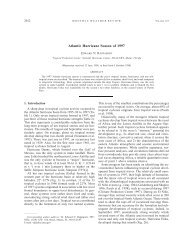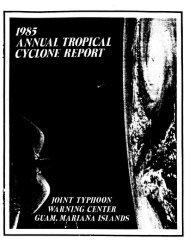Hurricane Gilbert Sept 3-16 1988 - NOAA
Hurricane Gilbert Sept 3-16 1988 - NOAA
Hurricane Gilbert Sept 3-16 1988 - NOAA
Create successful ePaper yourself
Turn your PDF publications into a flip-book with our unique Google optimized e-Paper software.
United States, 1; Jamaica, 45; Haiti, 30;<br />
Guatemala, 12; Honduras, 12; Dominican<br />
Republic, 5; Venezuela, 5; Costa Rim, 2;<br />
and Nicaragua, 2.<br />
Estimated damage with <strong>Gilbert</strong> was nearly<br />
$10 billion. Jamaica alone had $65 billion<br />
in damage and the damage to Mexico was<br />
estimated between $1 billion and $2 billion.<br />
Reports from the Mexican government indicate<br />
that more than 60,OOO homes were<br />
destroyed. The most extensive damage in<br />
the United States was from the tornadoes<br />
in San Antonio. Total damage in the<br />
United States was estimated at $33 million.<br />
With the exception of the tornadoes, hurricane<br />
induced damage in south Texas was<br />
light. Most damage was along the lower<br />
Texas Coast and the lower Rio Grande Valley<br />
from high winds and higher than normal<br />
tides. A few trees were uprooted and many<br />
limbs downed; however, only a few power<br />
poles and lines were downed. Agricultural<br />
damage was slight. Beach erosion ranged<br />
up to 4 feet along parts of the coast near<br />
Brownsville.<br />
CHAFTER 2<br />
SUMMARY OF NWS PREPAREDNESS<br />
ACTION, INFORMATION AND WARN-<br />
ING SERVICE.<br />
PreDaredness Act ions<br />
All National Weather Service (NWS) offices<br />
along the Texas coast (Beaumont-Pt.<br />
Arthur, Houston-Galveston, Victoria, Corpus<br />
Christi, and Brownsville) had performed<br />
extensive pre- and early hurricane<br />
season preparedness activities. Hundreds<br />
of presentations to the media, civic, industrial,<br />
and business groups reached<br />
thousands of people.<br />
4<br />
NWS officials met with emergency management<br />
coordinators (EMCs) before the hurricane<br />
season to ensure that strong links<br />
would exist between N WS offices and local<br />
emergency management offices during hurricane<br />
situations. Coordination with emergency<br />
management officials was<br />
strengthened in the Corpus Qristi, Victoria,<br />
and HoustodGalveston areas because<br />
of monthly emergency management<br />
meetings that are held throughout the year.<br />
These meetings were attended by the local<br />
NWS Meteorologist in Charge (MIC).<br />
As part of the NWS preparedness activities,<br />
Dr. Bob Sheets, Director of the NHC, participated<br />
in local meetings with all the mastal<br />
WSOs except Brownsville between May<br />
9-12. In total, over a thousand people attended<br />
these meetings and media coverage<br />
was extensive. Other preparedness actions<br />
by Weather Service Forecast Office<br />
(WSFO) San Antonio included organizing<br />
a comprehensive coastal humcane exercise<br />
to test AFOS backup procedures and links<br />
with the amateur radio groups along the<br />
coast. The successful drill was held July 28.<br />
Although no major problems were encountered<br />
during the storm, there appeared<br />
to be some confusion among EMCs and the<br />
public concerning hurricane tornadoes as<br />
well as the use of hurricane probabilities.<br />
<strong>Hurricane</strong> induced tornadoes tend to be<br />
small and weak. They do not have the Same<br />
characteristics as thunderstorm induced tornadoes<br />
and thus are more difficult to<br />
detect. The hurricane landfall probabilities<br />
were, at times, not used in conjunction with<br />
the 72- hour track.€orecasts and the two<br />
should be used together to show the uncertainty<br />
associated with forecasts of longer<br />
duration.<br />
7











